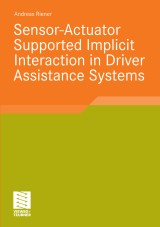Details

Sensor-Actuator Supported Implicit Interaction in Driver Assistance Systems
|
96,29 € |
|
| Verlag: | Vieweg & Teubner |
| Format: | |
| Veröffentl.: | 07.06.2011 |
| ISBN/EAN: | 9783834897770 |
| Sprache: | englisch |
| Anzahl Seiten: | 287 |
Dieses eBook enthält ein Wasserzeichen.
Beschreibungen
Technological advances, miniaturization of embedded computing technology and wireless c- munication together with the evolution of global networks like the Internet have brought the vision of pervasive and ubiquitous computing to life: technology seamlessly woven into the “fabric of everyday life”. Along with this development goes the need and challenge of int- faces supporting an intuitive, unobtrusive and distraction free interaction with such technolo- rich environments. Considering the huge amount, and ever growing number of a vast manifold of heterogeneous, small, embedded or mobile devices shaping the “pervasive computing la- scape”, makes traditional, explicit and attention based styles of interaction appear hopeless. To make computing part of everyday life, the interfacing must go beyond traditional explicit interaction: pervasive computing system designs will have to – and are already successfully attempting to – revert the principle of the user being in an active and attentive role, to one where technology is attentive and active. Interaction is becoming implicit. Implicit interaction is based on two main concepts: perception and interpretation. Perc- tion concerns gathering information about the environment and situations, usually involving (technological) sensors. Interpretation is the mechanism to understand the sensed data. C- ceptually, perception and interpretation when combined are described as situational context.
Research Hypotheses.- Perception.- Driver Expression.- Perception and Articulation.- Hypotheses and Research Questions.- Driver-Vehicle Interaction.- Vibro-Tactile Articulation and Presentation.- Information Needs of Drivers.- The Driver as the Weak Point in Interaction.- Driver Activity and Notification Demands.- Advanced Driver Assistance Systems (ADAS).- Vibro-Tactile Interfaces.- Methodology.- Analytical Methods.- Experiments.- Discussion and Conclusion.- Predeterminations for Investigation.- Reflecting on the Hypotheses.- Experiments: Lessons Learned.- Conclusion.- Future Prospects.
Dr. Andreas Riener is a research and teaching assistant at the Institute for Pervasive Computing, Johannes Kepler University Linz, Austria, and is employed as a researcher at the Research Institute for Pervasive Computing (RIPE) in Hagenberg, Austria.
The research trend in the automotive domain is clearly moving from mechanically controlled to computer assisted systems for both vehicle handling and comfort functions. Driver Assistance Systems (DAS), originally integrated to decrease the cognitive load and to increase the comfort for the driver, cause additional workload and stress for the driver, and as a consequence may distract from the main activity of driving and lead to traffic accidents.<br>
<br>
Andreas Riener studies the influence of implicit interaction using vibro-tactile actuators, invisibly and unobtrusively embedded into the car seat, as additional sensory channels for car-driver feedback, and pressure sensor mats, integrated into the seat for implicit information transmission from the driver toward the vehicle. The results of the experiments, e.g. implicit driver identification or activity recognition, vibro-tactile activity notification, motivate to use both vibro-tactile notifications and pressure sensor images to improve vehicle handling performance and to decrease the driver’s cognitive workload. <br>
<br>
<br>
Andreas Riener studies the influence of implicit interaction using vibro-tactile actuators, invisibly and unobtrusively embedded into the car seat, as additional sensory channels for car-driver feedback, and pressure sensor mats, integrated into the seat for implicit information transmission from the driver toward the vehicle. The results of the experiments, e.g. implicit driver identification or activity recognition, vibro-tactile activity notification, motivate to use both vibro-tactile notifications and pressure sensor images to improve vehicle handling performance and to decrease the driver’s cognitive workload. <br>
<br>
The research trend in the automotive domain is clearly moving from mechanically controlled to computer assisted systems for both vehicle handling and comfort functions. Driver Assistance Systems (DAS), originally integrated to decrease the cognitive load and to increase the comfort for the driver, cause additional workload and stress for the driver, and as a consequence may distract from the main activity of driving and lead to traffic accidents.<br>
<br>
Andreas Riener studies the influence of implicit interaction using vibro-tactile actuators, invisibly and unobtrusively embedded into the car seat, as additional sensory channels for car-driver feedback, and pressure sensor mats, integrated into the seat for implicit information transmission from the driver toward the vehicle. The results of the experiments, e.g. implicit driver identification or activity recognition, vibro-tactile activity notification, motivate to use both vibro-tactile notifications and pressure sensor images to improve vehicle handling performance and to decrease the driver’s cognitive workload. <br>
<br>
<br>
Andreas Riener studies the influence of implicit interaction using vibro-tactile actuators, invisibly and unobtrusively embedded into the car seat, as additional sensory channels for car-driver feedback, and pressure sensor mats, integrated into the seat for implicit information transmission from the driver toward the vehicle. The results of the experiments, e.g. implicit driver identification or activity recognition, vibro-tactile activity notification, motivate to use both vibro-tactile notifications and pressure sensor images to improve vehicle handling performance and to decrease the driver’s cognitive workload. <br>
<br>
Diese Produkte könnten Sie auch interessieren:

Neutron Applications in Earth, Energy and Environmental Sciences

von: Liyuan Liang, Romano Rinaldi, Helmut Schober

149,79 €

Nanobioelectronics - for Electronics, Biology, and Medicine

von: Andreas Offenhäusser, Ross Rinaldi

96,29 €














